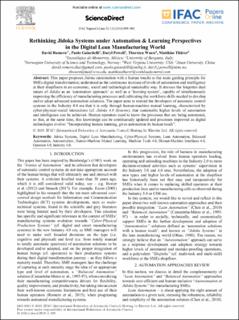| dc.contributor.author | Romero, David | |
| dc.contributor.author | Gaiardelli, Paolo | |
| dc.contributor.author | Powell, Daryl | |
| dc.contributor.author | Wuest, Thorsten | |
| dc.contributor.author | Thürer, Matthias | |
| dc.date.accessioned | 2020-04-24T07:05:37Z | |
| dc.date.available | 2020-04-24T07:05:37Z | |
| dc.date.created | 2020-01-27T14:17:47Z | |
| dc.date.issued | 2019 | |
| dc.identifier.citation | IFAC-PapersOnLine. 2019, 52 (13), 899-903. | en_US |
| dc.identifier.issn | 2405-8963 | |
| dc.identifier.uri | https://hdl.handle.net/11250/2652303 | |
| dc.description.abstract | This paper proposes Jidoka (automation with a human touch) as the main guiding principle for SMEs digital transformation; understood as the continuous increase of levels of automation and intelligence at their shopfloors in an economic, social and technological sustainable way. It stresses the forgotten dual nature of Jidoka as an ‘automation approach’ as well as a ‘learning system’, capable of simultaneously improving the efficiency of manufacturing processes and cultivating the workforce skills needed to develop and/or adopt advanced automation solutions. The paper aims to remind the developers of automatic control systems in the Industry 4.0 era that it is only through human-machine mutual learning, characterized by cyber-physical-social interactions (cf. Jidoka 4.0 Systems), that sustainable higher levels of automation and intelligence can be achieved. Human operators need to know the processes that are being automated, so that, at the same time, this knowledge can be continuously updated and processes improved as digital technologies evolve: “Incorporating human learning, gives automation its human touch”. | en_US |
| dc.language.iso | eng | en_US |
| dc.publisher | IFAC (International Federation of Automatic Control) | en_US |
| dc.rights | Attribution-NonCommercial-NoDerivatives 4.0 Internasjonal | * |
| dc.rights.uri | http://creativecommons.org/licenses/by-nc-nd/4.0/deed.no | * |
| dc.title | Rethinking Jidoka Systems under Automation and Learning Perspectives in the Digital Lean Manufacturing World | en_US |
| dc.type | Peer reviewed | en_US |
| dc.type | Journal article | en_US |
| dc.description.version | publishedVersion | en_US |
| dc.source.pagenumber | 899-903 | en_US |
| dc.source.volume | 52 | en_US |
| dc.source.journal | IFAC-PapersOnLine | en_US |
| dc.source.issue | 13 | en_US |
| dc.identifier.doi | 10.1016/j.ifacol.2019.11.309 | |
| dc.identifier.cristin | 1783193 | |
| dc.relation.project | Norges forskningsråd: 237900 | en_US |
| dc.description.localcode | © 2019, IFAC (International Federation of Automatic Control) Hosting by Elsevier Ltd. Under a Creative Commons CC-BY-NC-ND license (https://creativecommons.org/licenses/by-nc-nd/4.0/). | en_US |
| cristin.ispublished | true | |
| cristin.fulltext | postprint | |
| cristin.qualitycode | 1 | |

